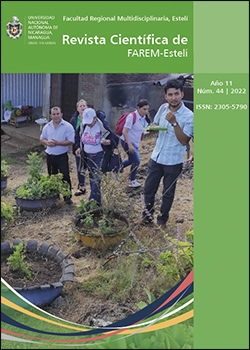Agronomic management of tomato and peppers carried out by members of the cooperative of vegetable producers COPRAHOR, in Sébaco-Matagalpa-Nicaragua
DOI:
https://doi.org/10.5377/farem.v11i44.15692Keywords:
Description, vegetables, management, agronomic, yieldsAbstract
In Nicaragua, tomato and pepper production is of great economic importance, both for its role as a source of foreign exchange, food source, as well as its potential to generate both rural and urban employment. However, their production is affected by a number of phytosanitary problems, climatic factors, as well as management problems, so the objective was to describe the agronomic management used in the production of tomato and pepper by the members of the cooperative of vegetable producers COPRAHOR, Through the application of a survey to 33 associated producers and 33 independent producers, the results show that the associated producers are better trained in various management issues, including post-harvest and marketing. 87% more in tomato and up to 7. 73% more in chiltoma, than the associated producers, the cooperative producers have more diversified their farm, they obtain better yields, among the planting materials most used by the associates is Ponny, Shanty and INTA-JL5, and among the chiltoma materials they prefer Nathaly, Tres cantos and 42-12, Both associates and independent producers use the 50 lb. box to transport and harvest their production and the associated producers deliver their harvest directly to the cooperative where it goes through a selection and washing process to later deliver it to supermarkets, the independent producers sell their production in the local market and to buyers who come to the production units.
Downloads
References
FAO (Organización de las Naciones Unidas para la Alimentación y la Agricultura, IT). 2014 El estado mundial de la agricultura y la alimentación. La innovación en la agricultura familiar. (en línea). Consultado 25 nov. 2022. Disponible en http://www.fao.org/3/a- i4036s.pdf
FAO, f. a. Organización de las Naciones Unidas para la Alimentación y la Agricultura. 2017, Nota de políticas sobre negocios inclusivo. Obtenido de http://www.fao.org/3/a-i7349s.pdf.
Galindo, Munch., & Lourdes Angeles, E. (1996). Métodos y técnicas de investigación para administración e ingeniería (No. 001.42 M 963m). México, MX: Trillas.
IICA (Instituto Interamericano de Cooperación para la Agricultura, CO). 2014. La innovación en la agricultura: un proceso clave para el desarrollo sostenible. (en línea). Consultado 5 ago. 2017. Disponible en http://www.redinnovagro.in/documentosinnov/Innovaci%C3%B3n_PP_es.pdf
INTA (Instituto Nicaragüense de tecnología agropecuaria). Manejo integrado de plagas. Cultivo de la chiltoma 2004. Managua, NI. 1ra Edición. 32p.
INTA (Instituto Nicaragüense de tecnología agropecuaria). Estudio agro socioeconómico de Hortalizas .2009. Managua, 12p.
NTON (Norma técnica obligatoria Nicaragüense para el empacado y transporte de frutas y hortalizas frescas 0306106, (En línea) https://www.ipsa.gob.ni, consultado el 20 de Enero del 2023.
Rodríguez, V. P; Guzmán, A. M; Zapata, M; Rengifo, M. T. Jaramillo, N. J; (2007). Manual Técnico Buenas prácticas agrícolas -BPA- en la producción de tomate bajo condiciones protegidas 331 p. Disponible en línea: http://www.fao.org/docrep/010/a1374s/a1374s00.htm. Consultado el 7 de octubre, 2009.
Jones, J; Stall, R; Zitter, T. 2001. Plagas y enfermedades del tomate. The American Phytopathological Society. Mundi-Prensa. Madrid, ES. 74p
Laguna, T., Pavon, J. F., Nicaragua Altamirano, K., & Estrada Rizo, C. (2004). Manejo integrado de plagas: Guía MIP en el cultivo de la chiltoma. Ministerio de Agricultura y Ganadería y Forestal, Managua (Nicaragua). Instituto Nicaragüense de Tecnología Agropecuaria, Managua (Nicaragua).
Téllez Espinoza, C. S., & Canda Pérez, M. A. (2006). Potencial de mercado en la cadena de comercialización del rubro tomate (Lycopersicon esculentum Mill) en los departamentos de Jinotega, Matagalpa, Estelí y Managua, en el período 2005-2006 (Doctoral dissertation, Universidad Nacional Agraria, UNA).
Published
How to Cite
Issue
Section
License
Copyright (c) 2023 Revista Científica de FAREM-Esteli

This work is licensed under a Creative Commons Attribution-NonCommercial-ShareAlike 4.0 International License.

